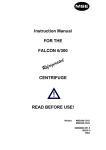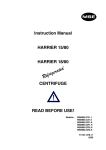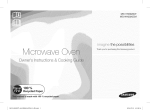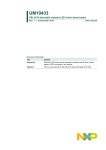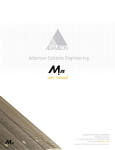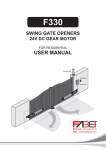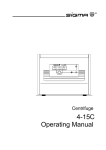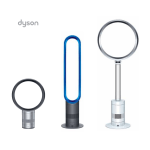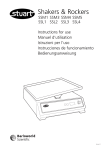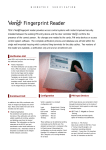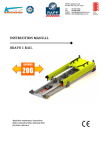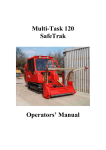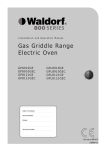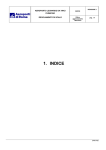Download MSE CENTAUR 2 - 71100.493 rev 04
Transcript
Instruction Manual For CENTAUR 2 CENTRIFUGE READ BEFORE USE! Models: MSB020.CX1.5 MSB020.CX1.1 71100-493-4 Health and Safety at Work MSE UK Ltd is required under the Health and Safety at Work Act, 1974 and other UK legislation as designers, manufacturers, suppliers and importers of articles for use at work to ensure that, as far as is reasonably practicable, articles which we design, produce, supply or import are safe and without risk to health. We are required to provide information on the safety and handling precautions to be observed when installing, operating, maintaining and servicing our products. Such advice is contained in this manual. We are also obliged to update this information should circumstances change and to operate a system to this end. We should also like to point out, however that you as users have an important responsibility in the provision and maintenance of safe working practices and conditions. Accordingly, we draw the following matters to your attention: 1. This apparatus should only be used as intended and within its design parameters by suitably qualified and trained personnel who have read and understood the relevant sections of this manual. 2. This manual should be readily available to such personnel at all times. 3. In addition to that which is written in the manual, normal common-sense safety precautions must be taken at all times to avoid the possibility of accidents. Particular care is required when working with apparatus at high temperature or pressure. 4. Installation, maintenance, repairs and servicing should only be carried out by a MSE (UK) Ltd approved engineer, and suitably trained personnel should only carry out connection to electrical supplies. TECHNICAL SUPPORT, WARRANTY SERVICE AND MAINTENANCE UK customers; if you are in any doubt whatsoever regarding the correct use of this apparatus, or if you require any technical data or assistance, please contact the MSE UK Ltd Technical Support Department at: MSE UK Ltd Worsley Bridge Road Lower Sydenham London SE26 5AZ Telephone Fax E-mail: Web Page: +44 (0) 870 609 4097 +44 (0) 208 650 8408 [email protected] www.mseuk.co.uk OVERSEAS CUSTOMERS: Should contact their local Distributor. ELECTRICITY SUPPLIES: Voltage and frequency MSE (UK) Ltd electrical apparatus is offered and labelled in a number of voltage ranges and, where necessary, different frequencies of mains supply. MSE UK Ltd does not accept any responsibility for the operation of any such apparatus should it be connected to electricity supplies which are normally outside, or vary outside, the stated voltage and frequency values for which it is designed, nor for any consequential loss, damage or injury, howsoever caused. MSE UK Ltd Warranty Terms and Conditions We hope that you do not have the need to use the extensive warranty cover that MSE UK Ltd. extends to you. However should you have a problem, our prompt response is greatly helped if you have filled in and posted the pre-paid Warranty Registration Card supplied with your new equipment. This entitles you to a one-year warranty from the date of delivery. During this period, component parts proven to be defective in materials or workmanship will be repaired or replaced at our expense. Installation, commissioning and calibration are not covered by this warranty agreement. The MSE approved service agent must be contacted for warranty determination and direction prior to any work being carried out. These warranties are only applicable to new products, and not second hand nor refurbished products even if repaired by MSE UK Ltd. Any such products are covered by separate warranty terms and conditions which will be made available on request. Replacement or repair of component parts or equipment under this warranty shall not extend the warranty to either the equipment or the component part beyond the original one-year warranty period unless agreed in writing by MSE UK Ltd. The above warranties are extended to the original purchaser upon full invoice payment. A purchase receipt or other proof of purchase may be required before warranty service will be performed. These warranties only cover failures due to defective workmanship which occur during the normal operation of the product by the original purchaser, and not failures which result from accident, misuse, abuse, neglect, mishandling, misapplication, alteration, faulty installation, electrical power fluctuations, dust, or other environmental extremes, modification or service other than by an approved service agent or following the written authority of the manufacturer, or damage that is attributable to acts of God. Expendable items such as motor brushes, door seals, lid seals, "O" rings or lamps are excluded. MSE UK Ltd, or its approved service agent, reserves the right to repair defective equipment on the premises of the customer, or at a service station, at the sole discretion of MSE UK Ltd or their approved agent. In the event of return to an approved service centre the customer is responsible for the safe packaging of the instrument and notification to the service centre. Neither MSE UK Ltd nor its agents are responsible for any damage occurring during shipment. Specification and Material Changes: MSE UK Ltd reserves the right to supply our latest and improved models at time of shipment. Taxes: The prices quoted do not include any taxes imposed by the State or Country in which the purchase was made. Installation: Installation of all equipment shall be at the expense of the purchaser unless stated otherwise. Access to the site, and the provision of required utilities e.g. Power, water and drainage to suitable connections, will be the responsibility of the purchaser, and at the purchaser's expense. Limitation of liability: In no event, whether as a result of breach of contract or warranty, shall MSE UK Ltd be liable for any consequential or incidental damages including, but not limited to, loss of profit or revenues, loss of use of the equipment or any associated equipment, down time costs, costs of substitute equipment, costs of labour, costs due to delays or claims of purchaser's own customers for such damages. The purchaser agrees to indemnify MSE Ltd and to hold them harmless from any and all liability, claims, demands, actions, suits, expenses or costs, including attorney's fees relating to such consequential or incidental damages. All expressed and implied warranties, including the warranties of merchantable quality and fitness for a particular purpose, are limited to the application period of one year. Validity: Legal rights vary from country to country and states within countries, so some or all of the exclusions or limitations listed above may not apply, but if any part of these conditions shall be found to be unenforceable it shall not affect the validity or enforceability of the remainder of the conditions. ELECTRICITY SUPPLY Before connecting this apparatus to the electricity supply, check the information given on the apparatus rating plate and ensure that; A) Your supply is single phase A.C. (alternating current) of the stated frequency with neutral nominally at earth potential. B) Your supply voltage is within the stated range. C) The current rating is within the capacity of your outlet. D) Your plug or electricity supply circuit is fitted with a suitable fuse. Fuse rating 220v - 240v 5 amp 110v - 120v see note for 110V - 120V WARNING! This apparatus must be earthed. The wires in the mains lead are coloured in accordance with the following code; Live Neutral Earth 220v - 240v Brown Blue Green and Yellow 110v - 120v Black White Green Connect the wires to a non-reversible 3-pin plug as follows; Green and Yellow or Green to terminal marked E (Earth), G (Ground), coloured Green or Green and Yellow or marked with the Earth symbol. Blue or White wires to terminal marked N (Neutral) or Common or coloured Blue. Brown or Black wires to terminal marked L (Live) or Phase or coloured Brown. Note 110v - 120v installations to comply with National and State Wiring Codes. IMPORTANT Consult an electrician if in any doubt or if your supply system has any of the following: No earth. A coloured code different from the above. Reversible plugs. Supply and return leads that are both above earth potential. NOTE: Do not touch plug pins within two seconds of plug removal from socket. CONTENTS 5 1. IMPORTANT INFORMATION................................................................................. 7 2. GENERAL DESCRIPTION ..................................................................................... 8 2.1 Controls And Indicators .................................................................................. 9 2.2 Centrifuge Bowl ............................................................................................. 10 2.3 Opening Lid Manually ................................................................................... 10 2.4 Specifications................................................................................................. 10 3. INSTALLATION .................................................................................................... 12 3.1 Preparation ..................................................................................................... 12 3.2 Connecting To 3 Pin Plug ............................................................................. 12 3.3 Recommendation For Securing Centrifuge ................................................ 13 4. ROTORS AND ACCESSORIES........................................................................... 14 4.1 Installation Of Rotor ...................................................................................... 14 4.2 Removal Of Rotor .......................................................................................... 14 4.3 Loading The Rotor......................................................................................... 15 4.4 Rotor Speed.................................................................................................... 15 4.5 Rotors And Accessories Tables................................................................... 16 4.5.1 4.5.2 4.5.3 4.5.4 4.5.5 4 Place Swing out rotor .................................................................................. 16 4 Place Swing out rotor .................................................................................. 17 8 Place Swing out rotor .................................................................................. 18 8 Place Angle rotor ......................................................................................... 19 12 Place Angle rotor ....................................................................................... 20 5. OPERATION ......................................................................................................... 21 5.1 Run Procedure ............................................................................................... 21 5.2 Stop Procedure .............................................................................................. 21 5.3 Imbalance ....................................................................................................... 21 5.4 Motor Thermal Cut-out .................................................................................. 21 5.5 Power Failure ................................................................................................. 21 5.6 Lid Safety Circuit ........................................................................................... 22 6. MAINTENANCE .................................................................................................... 23 6.1 Cleanliness ..................................................................................................... 23 6.2 Drive Shaft ...................................................................................................... 23 6.3 Prevention Of Corrosion ............................................................................... 23 6.4 O-Rings ........................................................................................................... 23 6.5 Sterilisation .................................................................................................... 23 6.6 Disinfecting .................................................................................................... 23 6.7 Inspection Or Renewal Of Motor Brushes .................................................. 23 6.8 Renewing The Fuse....................................................................................... 24 6.9 Removal And Replacement Of Centrifuge Bowl ........................................ 25 6.10 Lid Friction Adjustment ..................................................................... 25 7. SERVICING........................................................................................................... 26 7.1 Calibration Of Speed Control ....................................................................... 26 7.2 Removal Of The Motor .................................................................................. 26 CONTENTS 7.3 6 Adjustment Of Balance Detector.................................................................. 27 8. CIRCUIT DESCRIPTION ...................................................................................... 29 8.1 Power Input .................................................................................................... 29 8.2 Speed Control ................................................................................................ 29 8.3 Tacho Circuit .................................................................................................. 29 8.4 Speed Indication ............................................................................................ 30 8.5 Lid Safety Circuit ........................................................................................... 30 8.6 Balance Circuit............................................................................................... 30 9. ESSENTIAL PARTS LIST .................................................................................... 32 9.1 Body Assembly .............................................................................................. 32 9.2 Lid and Associated Assembly...................................................................... 32 9.3 Motor Assembly ............................................................................................. 33 9.4 PCB ‘A’ Assembly.......................................................................................... 33 9.5 PCB ‘D’ Assembly.......................................................................................... 33 9.6 Instrument Chassis Assembly ..................................................................... 34 10. PRODUCT DISPOSAL - ISO 14001 COMPLIANCE...................................... 34 11. HOW TO OBTAIN SERVICE ON YOUR FALCON CENTRIFUGE ............... 35 GENERAL INFORMATION 7 1. IMPORTANT INFORMATION The following general instructions, and the precautions regarding the prevention of corrosion in rotors and accessories, as described under MAINTENANCE, must be noted and carefully observed. The maximum load should always be checked before commencing any operation. If the sample has a relative density greater than 1.2, the maximum permissible speed of the rotor should be calculated as given in this publication, and applied. Any liquid spilt in the centrifuge should be removed immediately because corrosion is a major cause of failure in centrifuges. Where particularly corrosive solutions are used, the samples should be placed in sealed containers and all necessary precautions observed. The following list gives some examples of corrosive liquids used, particularly in the biochemical field: Phenol/cresol/water, chloroform/isoamyl alcohol, salt solutions (especially ammonium sulphate), solutions of ammonium hydroxide and solutions of acids such as hydrochloric, trichloroacetic and perchloric acids. It should be noted that many other substances used in different fields are often equally corrosive. Users should always check whether or not a substance being used is corrosive in order to take suitable precautions. NOTE: The following materials are prohibited: Flammable or explosive materials Materials which chemically interact vigorously The load must be distributed symmetrically round the rotating assembly so that it is evenly balanced and complies with the manufacturer's instructions in this respect. After use the sleeves and adaptors in centrifuge rotors should be removed to allow thorough cleaning of rotors and accessories and so prevent corrosion. Special care is necessary when using infective material in centrifuges. Containers, when used with such materials, should be closed while being centrifuged and sterilised immediately after use, using non-corrosive means. NOTE: Sealed containers and related components are intended to be part of biosafety systems such as are specified in international and national biosafety guide lines, and cannot be relied on as the only means of safeguarding workers and the environment when handling pathogenic micro-organisms. Care should be taken to preserve intact, sets of accessories which have been supplied as sets, in which all the members possess closely similar weights. It is advisable to have the centrifuge checked by a competent engineer, preferably the manufacturer's representative, at least every six months. Carbon brushes, whilst being of the highest quality obtainable are expressly excluded from the guarantee. A spare set is included in the accessory pack. The method of replacement is detailed in section 6.7 of this manual. GENERAL DESCRIPTION 8 2. GENERAL DESCRIPTION The Centaur 2 centrifuge is CE marked in line with required European Directives for Electromagnetic and Low Voltage Compatibility, see “Declaration of Conformity” for EC Directive/standard used. 120v units designed for CSA approval to the following standards: CAN/CSA C22.2 No. 1010.1-92 CAN/CSA C22.2 No. 1010.2.020-94 INDEPENDENT SPEED SENSING - 120 volt Machines only To comply with certain USA standards the 120 volt machines are fitted with a small window in the cover. This permits independent speed check directly from the rotor with use of an optically coupled tachometer. GENERAL DESCRIPTION 9 2.1 Controls And Indicators Figure 1. Control Panel of the Centaur 2 Centrifuge 1. The Power On rocker switch, when on (switch illuminated) connects power through to various circuits and components within the centrifuge. 2. The Fuse Holder carries a 20mm long, 5 Amp glass cartridge fuse. It is easily removable. 3. The Timer control allows a run period up to 30 minutes-selected by turning the knob clockwise. When the time selected has run out, the rotor will automatically run down to a stop. If required, the knob may be returned (anti-clockwise) to a lesser time or to the Off position at will. It cannot be turned anti-clockwise between the 'Hold' and '30' 'positions. The Hold position switches the centrifuge for continuous running until manually reset to Off. 4. The Rev/min indicator is a digital display giving continuous read-out of the rotational speed of the rotor, rounded off to the nearest hundred rev/min, e.g. 2500, 3200. 5. The Speed control allows selection of any speed between 300 rev/min and the maximum allowed for the rotor in use (see section 4.5 Rotors And Accessories Tables) as indicated on the Rev/min digital display. 6. The Imbalance indicator lamp (Red) when on, gives warning that the rotor is misloaded to a marked degree. In this event, drive to the rotor will cease and the rotor will run down to a stop. Loading and balance must be checked and corrected before re-starting the centrifuge. 7. The Lid Unlocked indicator lamp (Amber) when on, indicates that the rotor is at a standstill and the lid may be opened safely. When the rotor is spinning the lamp remains off and the lid is locked. GENERAL DESCRIPTION 10 2.2 Centrifuge Bowl The centrifuge bowl is easily removable for cleaning or disinfection purposes see section 6 (Maintenance). 2.3 Opening Lid Manually An electrical interlock prevents the lid being opened while the rotor is turning, or when the power is disconnected. If access to the rotor is required during a power failure, insert the Lid Lock Release Key (supplied with accessories) to its fullest extent, into the small hole on the top of the lid, near the front; move the point towards the rear against a slight spring pressure to actuate the lid lock mechanism. Press the lid actuator to the right and open the lid. The lid is friction-controlled, to remain open at any intermediate position desired. Front Figure 2. Manual Over-ride of Lid Lock 2.4 Specifications Dimensions Height 336mm (with lid open - 470mm) Width 436mm Depth 487mm Weight 36kg (without rotor) Power Supply Input voltage and frequency. Cat. No. MSB020.CX1.5 220/240V 50/60 Hz. Cat. No. MSB020.CX1.1 110/120V 50/60 Hz. Operating Humidity MRH 80% up to 31°C decreasing linearly to 50% RH at 40°C Altitude Up to 2000M NOTE: Motor, as fitted, contains overtemperature cut-out device. GENERAL DESCRIPTION Accessories Supplied With The Centrifuge Part No. 32600.019 76600.004 88110.024 71100.493 71100.958 71100.1052 82120.143 Description Quantity Fuse 5A (20mm) 1 Lid Lock Release Key 1 Lid Seal Insertion Tool 1 Operating Manual 1 Guarantee Card 240V 1 Guarantee Card 120V 1 Spindle Nut 1 (for Rotors 34121-607, 34117-603, 34117-604 only) 11 INSTALLATION 12 3. INSTALLATION IMPORTANT: The rotor must not be fitted when moving or during transit. 3.1 Preparation Remove the centrifuge from its packing and place it on a rigid, level surface. Check that the available power supply corresponds to that stated on the voltage plate fixed to the rear panel of the centrifuge. NOTE: (i) An electrical interlock prevents the lid being opened unless the centrifuge is connected to the power supply. (ii) It is important that, at least, 100mm clearance is allowed at the sides and rear of the centrifuge when placed in the final operating position. NOTE: Laboratory management procedures should require that no person or any hazardous materials are within a 300mm boundary while the centrifuge is operating. 3.2 Connecting To 3 Pin Plug Connect the 3-core cable to a 3-pin plug fitted with a 5 Amp fuse as follows: WARNING! This equipment must be earthed. Brown wire to Live (L) Terminal Blue wire to Neutral (N) Terminal Yellow/Green wire to Earth (E) Terminal Connect the centrifuge to the power supply and press the Power switch on. The Power On and the Lid Unlocked indicators will come on. Push the lid lock actuator to the right and open the lid. NOTE: BS EN 61010-2-020 ‘Particular Requirements for Centrifuges’ states that a remote switch, preferably adjacent to the room exit is a requirement in case of unit malfunction. INSTALLATION 13 3.3 Recommendation For Securing Centrifuge A Fixing Kit for securing the Centaur 2 centrifuge to a suitably sound worktop is for securing centrifuge available from MSE as an optional accessory. It consists of an anchor bracket which is secured to the bench, or table, by two screws with nuts and washers; and two screws which screw into the body of the centrifuge to secure it to the bracket. See Figure 3. Figure 3 Securing Centrifuge to work surface using Bench fixing Kit (Part No. 41159.188) If the restraint kit is not used to secure the centrifuge on the bench then, it is the recommendation of BS EN61010-2-020 that a clearance of 300mm is allowed around the base of the centrifuge when in the final operating position. NOTE: Laboratory management procedures should require that no person or any hazardous materials are within a 300mm boundary while the centrifuge is operating. Figure 3a Recommended Clearances Note: 75mm if solid surface (i.e. wall) otherwise 300mm ROTORS AND ACCESSORIES 14 4. ROTORS AND ACCESSORIES 4.1 Installation Of Rotor Before fitting a rotor to the centrifuge ensure that the drive shaft is lightly smeared with petroleum jelly. Check that the rotor is clean - particularly pockets in angle rotors. Locate the rotor on the drive shaft and, ensuring that the correct spindle nut for the rotor in use is employed (see sections 0 & 4.5), engage and tighten the spindle nut finger tight. 4.2 Removal Of Rotor Press Power switch off. Open the centrifuge lid. Remove all rotor accessories, i.e. buckets, trunnions etc. Loosen the spindle nut a few turns, grip the rotor as illustrated in Figure 4 and pull upwards with the fingers whilst gently rocking the rotor and applying downward pressure with the thumbs, to release it from the drive shaft. Remove the nut and lift the rotor free. Note: Do not attempt to loosen the rotor by tapping on the centrifuge motor spindle. Figure 4. Removing Rotor from Drive Shaft ROTORS AND ACCESSORIES 15 4.3 Loading The Rotor The rotors must carry a full complement of cups/buckets and/or trunnion rings, but all cups/buckets need not be loaded. Loads must be placed symmetrically about the rotor and opposing loads should balance to within 2 grams. Where possible, balancing by sight is usually sufficient. Before loading centrifuge tubes ensure that the appropriate colour coded-adapter or rubber cushion is correctly positioned in the cup/bucket. Check that all tubes project equally from the upper surface of the rotor. Finally, if using a swing-out rotor, check that all cups of trunnion rings swing freely. If necessary, apply a light smear of petroleum jelly to the rotor pivot slots. Failure to load the rotor correctly can result in serious imbalance and possible damage to the centrifuge. Biologically hazardous material should only be centrifuged in sealed buckets or cups. 4.4 Rotor Speed Maximum Speeds of rotors (See section 4.5) are calculated on the basis of tubes filled with a sample of specific gravity 1.2. If liquids of higher specific gravity are used, the maximum speed of the rotor must be reduced according to the formula: Where M = New maximum speed N = Maximum rotor speed at 1.2 specific gravity S = Specific gravity of sample used ROTORS AND ACCESSORIES 16 4.5 Rotors And Accessories Tables The centrifuge complies with the requirements of BS4402 only when fitted with one of the following rotors. * Max. rev/min at 240V or 110V Haem. Haematocrit tube ** Supplied as standard with buckets Wass. Wasserman glass tube # Available as spares 4.5.1 4 Place Swing out rotor 43124-126 (includes spindle nut) Cup (Set of 4) Sealed Cup 43551-121 43551-121 43551-121 43551-121 43551-121 43551-121 43551-121 Open Cup 34421-639 Adaptor (Set of 4) 34159-302 (brown) 34159-301 (yellow) 34159-304 (green) 34159-303 (grey) 34159-305 (orange) 34159-306 (blue) As above Rotor Capacity Max.* Speed Max. RCF Max. Tube Size Dia (mm) Ht (mm) 4 x 200ml 4 x 100ml 3300 3300 2000 2000 57 39.5 116 113 4 x 50ml 3300 2000 29 113 28 x 15ml 3300 2000 17 110 16 x 10ml DSS 3300 2000 16.5 105 36 x 13∅ mm 3300 2000 13 110 48 x 12 ∅ mm 3300 2000 12 110 As above 3600 2200 ROTORS AND ACCESSORIES 17 4.5.2 4 Place Swing out rotor 34121-607 Bucket Trunnion 34411-912 34134-604 Sealing cap 43561-156 can be used if required 34134-605 34411-909 Sealing cap assy 43561-606 can be used if required 34411-904 34136-102 34136-103 Adaptor/ Cushion Rotor Capacity Max.* Speed Max. RCF Max. Tube Size Dia (mm) 42 29 17 13 Ht (mm) 125 120 118 118 34142-105** 34144-308 34151-302 34153-302 4 x 100ml 4 x 50ml 8 x 15ml 20 x 7ml 3500 3500 3500 3500 2246 2246 2246 2246 34142-104** 34148-705 34141-114 34141-115 34144-307 34153-304 34151-301 4 x 50ml 4 x 50ml 4 x 1oz 4 x 1oz 4 x 15ml 24 x Haem 8 x Wass 4200 4200 4200 4200 4200 4200 4200 3130 3130 3130 3130 3130 3130 3130 30 conical 29 Glass Sterilin 17.5 7.7 12.7 118 112 34142-101** 34142-101** 43161-103 34148-101 34146-104 34146-103 34146-102 8 x 15ml 16 x 15ml 16 x 15ml 16 x Haem. 16 x 5 or 3ml 16 x 2ml 16 x 0.5 or 1ml 4000 3400 3400 3400 3400 3400 3400 2612 2000 2000 2000 2000 2000 2000 17 17 conical 17 7.7 13 12 9 120 120 115 120 120 100 100 110 120 120 ROTORS AND ACCESSORIES 18 4.5.3 8 Place Swing out rotor 43121-111 (includes buckets and spindle nut) Bucket 34411-905# Trunnion Adaptor/ Cushion 34142-101** Rotor Capacity 8 x 15ml Max.* Speed 3500 Max. RCF 2200 Max. Tube Size Dia (mm) 17 Ht (mm) 115 ROTORS AND ACCESSORIES 19 4.5.4 8 Place Angle rotor 34117-603 Bucket 34411-909 34411-909 34411-909 34411-909 34411-909 34411-909 34411-909 Trunnion Adaptor/ Cushion 34142-104** 34148-705 34141-114 34141-115 34144-307 34153-304 34151-301 Rotor Capacity 8 x 50ml 8 x 50ml 8 x 1oz 8 x 1oz 8 x 15ml 48 x Haem. 16 x Wass. Max.* Speed 4600 4600 4600 4600 4600 4600 4600 Max. RCF 3120 3120 3120 3120 3120 3120 3120 Max. Tube Size Dia Ht (mm) (mm) 29 110 conical 29 110 Glass Sterilin 17.5 110 7.7 120 12.7 120 ROTORS AND ACCESSORIES 20 4.5.5 12 Place Angle rotor 34117-604 Bucket 34411-904 34411-904 34411-904 34411-904 34411-904 34411-904 Trunnion Adaptor/ Cushion 34142-101** 43161-103 34148-101 34146-104 34146-103 34146-102 Rotor Capacity 12 x 15ml 12 x 15ml 12 x Haem. 12 x 5 or 3ml 12 x 2ml 12 x 0.5 or 1ml Max.* Speed 4600 4600 4600 4600 4600 4600 Max. RCF 3000 3000 3000 3000 3000 3000 Max. Tube Size Dia (mm) 17 conical 17 7.7 13 12 9 Ht (mm) 110 110 110 120 100 100 OPERATION 21 5. OPERATION 5.1 Run Procedure Ensure that the Rotor is correctly loaded and secured and the Timer set at Off. Close the lid and press down firmly. Press the Power switch on. The Power On and the Lid Unlocked indicators will come on. Select Timer to Hold, for continuous running, or to the time required. The lid will now be locked - Lid Unlocked indicator off. Select required speed (between 300 rev/min and the maximum speed of the rotor in use, see section 4.5) by adjusting the Speed control until the required speed is indicated on the Rev/min digital display. For repeat runs the Speed control need not be moved from the position originally selected. 5.2 Stop Procedure To terminate a run in the Hold mode, set the Timer switch to off and the rotor will run down smoothly to a stop. In the Time mode the centrifuge will run down automatically when the selected time has run out. In both modes automatic braking is applied, and when the rotor has stopped, the Lid unlocked indicator will come on. Open the lid; the Lid unlocked indicator will go off. 5.3 Imbalance Should the imbalance indicator lamp come on, the centrifuge will run down. When the digital panel meter indicates four zero’s, turn the Power switch and Timer to off and wait thirty seconds, then turn the Power switch on. The lid unlocked indicator will come on; open the lid; check the balance of the rotor; close the lid and restart the run. 5.4 Motor Thermal Cut-out The motor is fitted with a ‘self re-setting’ thermal cut-out to protect the motor from over-heating. If the thermal cut-out has operated during a run the rotor will stop and ‘0000’ will be displayed. The centrifuge will return to normal operation once the motor has cooled. IMPORTANT: ENSURE THAT THE VENTILATION SLOTS AT THE BACK ARE NOT OBSTRUCTED IN ANY WAY. 5.5 Power Failure If the mains power to the centrifuge is interrupted during a run, the rotor will coast down to a stop and the lid will remain locked. Turn the Timer control to off. When the power is restored, re-start the run as normal. If it is required to gain access to the rotor during the power failure, use the Lid Lock Release Key (see section 2.3). If power failure occurs and the centrifuge is left unattended, subsequent restoration of power will cause the centrifuge, if in the Hold mode, to run up to the originally selected speed. If in the Time mode, the centrifuge will run up to speed and continue for the time left on the Timer. If the selected time runs out during the power failure, the lid will remain locked for an inherent delay period of approximately 3½ minutes from the time of power failure, even if the power is restored within this period. OPERATION 22 5.6 Lid Safety Circuit The Lid Safety Circuit has a dual function: i. It prevents power being switched to the motor until the lid is properly closed. ii. It imposes a delay of approximately three and a half minutes in the event of a tacho failure before the Lid Unlocked indicator comes on and the lid can be opened. Two micro-switches in the lid form part of the lid safety circuit. These can be checked for correct operation as follows: i. Press Power switch on and open the lid. The Lid Unlocked indicator lamp should be off. ii. Close the lid. The Lid Unlocked indicator lamp should come on. If the lamp does not come on, check that the lid is firmly closed as this is the most likely cause of malfunction . iii. Switch the Timer to Hold or select a Time. The Lid Unlocked indicator should go off. If this does not occur, then the Lid Locked microswitch has not operated. Again, the most likely cause is improper closing of the lid. MAINTENANCE 23 6. MAINTENANCE DISCONNECT THE CENTRIFUGE FROM THE POWER SUPPLY User maintenance is minimal, being confined mainly to cleanliness and care of rotors and accessories. Basic equipment maintenance must be carried out by a qualified/competent electrician. 6.1 Cleanliness Ensure that the body of the centrifuge is cleaned periodically to maintain a good appearance. It is particularly essential to clean out the centrifuge bowl thoroughly, especially when corrosive materials have been used. A soft cloth dampened in a solution of mild detergent and warm water will serve for both purposes. 6.2 Drive Shaft The centrifuge drive shaft should be cleaned periodically with a solvent to remove excessive grease. When clean, the shaft should be re-lubricated lightly with petroleum jelly. 6.3 Prevention Of Corrosion Simple corrosion can usually be detected by eye and appears in the form of pitting, or white, fluffy deposits on the surface of aluminium rotors. To prevent corrosion, take care to avoid scratching the surface of rotors and/or accessories. After use wash rotors, metal buckets, cups, carriers and adaptors in warm soapy water, dry and store, inverted, in a dry place. Rotors should be protected with MSE Rotor Spray (Cat. No.17341.151), which is an anti-corrosion and de-waterising agent. In addition, rotors should be periodically inspected by a responsible person so that corrosion can be detected at the onset. Contact MSE (UK) Ltd Technical Support for further advice on this subject. 6.4 O-Rings Ensure O-Rings are lightly coated with silicone grease. Check O-Rings regularly for cuts and abrasions. Seals should be replaced as necessary, or at least once a year. 6.5 Sterilisation Except for the 8-place swing-out rotor Cat. No. 43121.111, all rotors, buckets, sealing caps (O-Rings removed) and the bowl may be sterilised by autoclaving at 120°C. See section 6.9 for bowl removal procedure. If the means available for disinfection of certain microbiological agents are inadequate, the safety officer should be consulted and appropriate steps taken 6.6 Disinfecting The following cleaning fluids may be used TERMINEX 2 (Available from Arrow Chemicals Ltd.) VIRKON (Available from Antec International) These cleaning agents if used as instructed by the manufacturer should not be harmful to this product, or accessories supplied for use with this product. WARNING: SOLVENTS OR GRITTY CLEANERS SHOULD NEVER BE USED EXCESSIVE USE OF WATER SHOULD ALSO BE AVOIDED 6.7 Inspection Or Renewal Of Motor Brushes MAINTENANCE 24 The motor brushes should last for a minimum of 1000 hours of operation. To renew brushes proceed as follows: Open the lid and remove the rotor, close the lid, and disconnect the centrifuge from the power supply. Turn the centrifuge on to its back Unscrew and remove the two screws securing the front rubber feet, and the other two screws that locate and secure the instrument chassis to the base frame. Place corrugated cardboard or other protection on the upper part of the centrifuge, then withdraw and lay the chassis on top Removing The Brushes Unscrew the brush-retaining cap. The brush is held within a carrier against a tensator roll spring. If the carrier does not spring free on removal of the cap, a thin, stiff wire, hooked at one end may be used to assist. Do not use force. Gently press the arms of the carrier together and withdraw the brush. On withdrawal, note the position of the roll spring in the carrier in relation to the brush and motor as the new brush must be fitted in the same manner. It will be seen that a small pin, fitted near the rear end of the brush locates in a guide slot along one arm of the carrier. Note that the free end (tongue) of the roll spring is held, near the end of one arm of the carrier, facing in the direction of fitting. Fitting New Brushes Locate the new brush in the carrier with the pin located in the slot and the brush pushed fully into the carrier against the tension of the roll spring Hold the assembly together with the roll spring in the same relationship to brush and motor as when the old brush was removed, and insert the front end into the brush housing of the motor Take care to ensure that the 'tongue' of the roll spring lies, facing forward, flat with the carrier (if not, gently press it down with a small screwdriver) before pushing the assembly home into the brush housing. Note: If the 'tongue is bent backwards against the carrier upon insertion, it may break off and the spring will be ineffective Check that the carrier moves freely in and out against the tension of the spring. Refit the brush-retaining cap and tighten fingertight. Replace and secure the instrument chassis and the rubber feet and turn the centrifuge the right way up. Run the centrifuge with an unloaded rotor on the drive shaft to a speed of 1000 rev/min for half-an-hour, to bed in the brushes. 6.8 Renewing The Fuse To renew the fuse: disconnect the centrifuge from the power supply at the mains plug. Unscrew the fuse holder cap and remove the fuse. Inspect and replace as necessary with the correct rating. For 220V/240V model, the plug fuse may also need to be checked. Fit the new fuse and refit the holder back into the receptacle. If the fuse blows again during use, contact the local distributor, or MSE (UK) Ltd. NB - If the fuse blows immediately or blows again during normal use, the power supply should be disconnected and the service engineer called. MAINTENANCE 25 6.9 Removal And Replacement Of Centrifuge Bowl To remove the bowl for cleaning or disinfection purposes proceed as follows: Open the lid, disconnect the centrifuge from the power supply and remove the rotor (if fitted). Peel back the lip of the seal above the bowl vent (inside the bowl at right) note position of the vent then lift the bowl by the vent hole above the seal at this point. Now lift the bowl by the centre boss and work the seal lip away from around the entire circumference of the bowl. To refit the bowl: Bend the lip of the seal to point upwards at any convenient position. Lower the base of the bowl on to the seal and work the seal around the side of the bowl so that the whole seal edge is pointing upwards and embracing the lower part of the bowl. Lower the bowl, applying slight downward pressure with a twisting motion and ease downwards until the seal lip is just under the bowl rim, with the vent in the bowl in original (noted) position. Insert the lid seal tool (Figure 5.) between the seal and the lip of the bowl and ease the seal over the lip of the bowl while applying downward pressure on the bowl centre boss. Work the tool round the rim of the bowl gently easing the seal over the bowl. Exert further downward pressure on the boss to locate the bowl rim in the recess of the seal. Figure 5. Use of lid seal tool 6.10 Lid Friction Adjustment If the lid friction collar needs adjustment, e.g., because lid falls slowly downwards, turn the socket screw, which is visible through the small hole located centrally near the lower edge of the inside of the lid, using a 4mm socket wrench. Turning clockwise will tighten, and anti-clockwise will loosen, friction resistance on the lid. See Figure 6 (upper inset, annotation 20). SERVICING 26 7. SERVICING This section has been included for the guidance of competent service engineers only - preferably those trained by MSE (UK) Ltd. 7.1 Calibration Of Speed Control Disconnect the centrifuge from the power supply Remove the instrument chassis (see section 6.7 for removal instructions). Refit the two rubber feet temporarily and set the centrifuge upright with the instrument panel at the front. Connect 2 frequency metre to test points TP1 (ground) and TP2 (signal) at the right hand side of the circuit board. Place a correctly assembled and balanced rotor (see section 4) on the drive shaft, close the lid and set the speed control and RV2 - PCB 'D' fully anti-clockwise, set RV3 - PCB 'A' fully clockwise. Switch on, turn the timer to ‘Hold’ and check that the rotor rotates slowly and the centrifuge display indicates 100 rpm, if necessary, adjust RV2 - PCB 'A' (min speed set) to achieve this condition. Set the speed control fully clockwise, adjust RV1 - PCB 'A' until the frequency meter reading matches half (1/2) that of the centrifuge display reading, adjustment clockwise will increase the display reading whilst decreasing the meter reading and vice-versa for anti-clockwise. Adjust RV2 - PCB 'D' (max. speed set) so that the centrifuge runs at the highest speed indicated on both the centrifuge and frequency meter displays. 7.2 Removal Of The Motor Ensure that there is no rotor on the drive shaft. With the centrifuge turned on to its back and the instrument chassis removed (section 6.7), remove the remaining screws around the edges of the base plate. Making a note of terminations and connections for reference, disconnect plugs and wires and remove the base-platewith-motor. The upper part of the motor is partially secured by the rubber support disc in the body and can be pulled out. Remove the three nuts and spring washers which secure the three rubber mounts to the base plate. Remove the motor assembly from the base plate. Remove the two hexagon screws, washers and spacers (note arrangement) and remove the optical detector printed circuit board. Remove the screw in the lower end of the motor and carefully remove the plastic tacho disc. The motor can now be detached from the tacho box by removing the three small screws around the centre of the tacho box. Carefully note location and position of the motor support bush around the body of the motor before removal. Remove the motor support bush and fit it to the new motor as noted, before re-assembly. Re-assembly of the motor to the tacho box and base plate is a reversal of removal procedures. Ensure that the tacho disc is centred within the slot of the optical detector. Ensure also that the three rubber mounts are not twisted during reassembly. Adjust balance detector as described in section 7.3. SERVICING 27 7.3 Adjustment Of Balance Detector With the centrifuge upright and after operation with a loaded rotor for a few minutes, to allow the motor to settle in its operating position, insert a 1mm thick gauge between the microswitch actuator and the side of the tacho-box (Item 6. Figure 6). By turning the Balance detector adjusting screw, Item 7, Figure 6 adjust the microswitch towards the side of the tacho-box until the microswitch just operates (breaks). Ensure that the microswitch operates (re-makes) when the gauge is removed. SERVICING 28 Figure 6 Partially Exploded View Of Centaur 2 CIRCUIT DESCRIPTION 29 8. CIRCUIT DESCRIPTION 8.1 Power Input A.C. mains power is fed to the centrifuge via a double-pole switch SW1, a 5 Amp fuse FS1 and a filter. The Power switch SW1, when switched on, is illuminated by a green neon lamp. 8.2 Speed Control The motor current is phase-controlled by a series triac MR1 which is triggered by an opto-isolator IC1. The L.E.D. of the opto-oscillator is driven by a section of the transistor driver IC2 which in turn is fed from two cascaded Schmitt triggers IC4. The input terminal of the first Schmitt trigger is connected to a 68nF capacitor, which is discharged to approximately 1 Volt during each mains cross-over by IC2 pins 2, 15 and 3, 14. the Potentiometer RV2 (PCB A) sets the low end of the speed range and RV2 (PCB D) set the maximum speed. RV4 is for speed control. The pulse width generated by this circuit is linearly proportional to the speed control resistance. There is, however, some non-linearity in the speed versus speed-control angle characteristic because the pulse is used to "chop" a sine wave in order to vary the speed. The feedback network R18, MR10 discharges the capacitor to give a narrow trigger pulse, thus reducing the power requirement on the 12 Volt supply to IC1. Voltage is fed to the speed control network via the Lid Closed and the Lid Locked micro-switches SW2 and SW3 and one contact of the Timer switch, SW4/1, so that the motor is driven only when the lid is closed and locked and the Timer is set to Hold; or a time is selected. The voltage is stabilised at about 9 Volts by R17, MR7 and the 8.2 Volts supply. Relay A is also fed through the two micro-switches and the Timer switch contact. When Relay A is energised, the motor field and armature are connected in series with each other and the triac MR1, across the 240 Volts mains input. With Relay A released (which occurs when the Timer switches off), the armature is shortcircuited and a D.C. voltage is applied to the field. This applies a braking force to the motor. 8.3 Tacho Circuit The tacho input is taken from an opto-electronic chopper unit, which gives an output of rev / Min Hz. This input switches VT1 which provides a fixed voltage (≈8V) 2 square wave to the Speed Indication and Lid Safety Circuits. CIRCUIT DESCRIPTION 30 8.4 Speed Indication The output of VT1 is fed, via a Schmitt trigger, to a monostable circuit (IC3 pins 4, 5, 6, 8, 9 and 10). The pulse width is fixed by a time constant of 22 nf and a 50k variable resistor RV1. The output pulses are fed to the digital display unit (PCB D) where they are integrated to give a D.C. voltage proportional to speed. The digital display unit consists of a 7107 analogue-to-digital converter/driver I.C. and its associated components, driving two LED's. The two most significant digits are driven by the 7107 to indicate the speed. The two least significant digits are connected through twelve 1k resistors (RN1) to give a fixed 00 display. 8.5 Lid Safety Circuit When the Timer switch is made, contact SW4/2 applies a voltage to charge up C8. This sets one input of the NOR gate IC3 pins 11 to 13, to ‘1’, thus deenergising the Lid Solenoid and locking the lid. When the Timer switches to ‘Off’ the charging current to C8 ceases, but the discharge time constant is long enough to delay the energising of the solenoid for about three-and-a-half minutes. This ensures that the lid cannot be opened before the rotor has stopped. To allow the lid to be opened as soon as the rotor stops, the circuit comprising: IC4 pins 1, 2, 3, 4, 5 and 6; IC3 pins 1, 2 and 3, together with VT2, monitors that the run-down is normal and if so, discharges the capacitor C8. The method employed uses the outputs of two frequency discriminators: IC4 pins 5 and 6 (directly) and IC4 pins 1, 2, 3 and 4 (after a delay) as inputs to a NOR gate. If the 60 rev/min discriminator operates sufficiently in advance of the 6 rev/min circuit, then a pulse is generated by the NOR gate which switches on VT2, to discharge the capacitor. Under failure conditions no pulse will be generated and the lid will remain locked for about three-and-a-half minutes. 8.6 Balance Circuit IC2 pins 4/13 and 5/12 form a bi-stable circuit, which is forced into the required stable state at switch-on by the capacitor C5. In this stable state pin 13 is near earth so that Relay A can be energised; and pin 12 is high so that the balance lamp is off. If the rotor is unbalanced sufficiently to cause the Balance microswitch to open momentarily, the bi-stable circuit will switch over to its other stable state. IC2 pin 13 will then be high, de-energising the relay. Pin 12 will be low, switching the Balance lamp LP2 on and removing the charging current to C8, so that the lid is unlocked after about three-and-a-half minutes. The bi-stable can be reset by switching the mains supply off for a few seconds and then on again. CIRCUIT DESCRIPTION 31 PARTS LIST 32 ESSENTIAL PARTS LIST 8.7 Body Assembly Part No. Description 93600.078 Bowl Liner 26600.001 Bowl Seal 71500.055 Motor-Support Bush 96500.015 Retaining Ring 73050.002 Rubber Foot 96500.225 Black Plug Button 72100.121 Left-hand Side Panel 72100.120 Right-hand Side Panel 88120.040 Lid Stop Remarks 8.8 Lid and Associated Assembly 72900.045 Left-hand Torsion Spring 72900.046 Right-hand Torsion Spring 72100.122 Lid Handle 88120.039 Catch Pin 72900.048 Catch Spring 36020.028 Micro-Switch Lid Closed, SW2 36020.027 Micro-Switch Lid Lock, SW3 60800.001 Solenoid Lid Lock 72900.047 Solenoid Spring Lid Lock 72900.042 Spring Lid Lock PARTS LIST 33 8.9 Motor Assembly Part No. Description 34400.159 Motor (for 220/240V - 50/60Hz) 34400.160 Motor (for 100/120V - 50/60Hz) 78070.013 Motor Seal 73030.001 Anti-vibration Mount 82120.143 Spindle Nut 72100.115 Tacho Disc 61080.036 Optical Tacho PCB Assembly 42050.003 Slotted Optical Switch Remarks For rotors 34121.607 34117.603, 34117.604 only 8.10 PCB ‘A’ Assembly 61080.043 Printed Circuit Board ‘A’ Assembly 43040.042 Opto-isolator 4N33 IC1 43040.029 Transistor Driver ULN2004 IC2 43030.003 Quad NOR Gate 4001 IC3 43030.002 Schmitt Trigger 74C14 or 40106 IC4 46060.039 Transistor BC184L, 30V 200mA NPN VT1, VT2 46080.013 Triac MR1 42040.012 Diode IN4002 MR2 42030.020 Diode Bridge KBPC 104 400V 2A MR3 42040.013 Diode IN4148 MR4, 5, 7, 8, 9, 10, 11, 12, 13, 14, 15, 16, 17 42020.024 Zener Diode BZX61, 8.2V 1.3W MR6 8.11 PCB ‘D’ Assembly 61080.079 Printed Circuit Board ‘D’ Assembly 43040.043 A to D Converter & LED Driver 7107 IC1 42050.004 2-digit LED. 42020.023 Zener Diode BZV85, 5V1 1.3W MR1 42040.013 Diode IN4148 MR2, 3 PARTS LIST 34 8.12 Instrument Chassis Assembly Part No. Description Remarks 32600.019 Fuse 5A (20mm) 32900.037 Fuse Holder 38700.046 Timer Switch, 30 min, 16A, 250V 44050.035 Potentiometer, Speed Control 76070.099 Knob 28mm Black 76070.095 Knob 28mm Black 76070.096 Cap 28mm Black 76070.097 Pointer 28mm Grey 36040.067 Rocker Switch 240V 36040.068 Rocker Switch 110V 34060.013 Indicator Lamp, Red Imbalance 34020.087 Indicator Lamp, Amber Lid Unlocked 35080.046 Relay RLA 46100.003 Filter 38900.042 Transformer RV4 Speed/Timer Control Power On TR1 9. Product Disposal - ISO 14001 Compliance This product should be treated as industrial waste and disposed of accordingly. There are no toxic material used in the manufacture of this product. The majority of materials used in this product are recyclable, and all can be disposed of safely. Where the product has refrigeration, it is important that prior to disposal the refrigerant gas is recovered by a qualified person. The insulation material is non-toxic but could be an irritant. If removed from the product it should be bagged and disposed of at an authorised site. HOW TO OBTAIN SERVICE 35 10. HOW TO OBTAIN SERVICE ON YOUR CENTRIFUGE MSE UK Ltd is committed to giving our customers the best possible service. If your centrifuge should require service at any time please follow these procedures: All countries except UK, USA and CANADA - Contact your local MSE (UK) Ltd distributor UK only For all technical and service enquires contact: MSE (UK) Ltd Worsley Bridge Road Lower Sydenham London SE26 5AZ Telephone +44 (0) 870 609 4097 Fax +44 (0) 208 650 8408 E-mail: [email protected] 1. Contact the repairs centre - have the model, serial number, and date of purchase and fault description available. 2. You will be given a return goods authorisation number and directions for shipping. 3. Remove all rotors, buckets and adapters. Do not ship these items - only the centrifuge. 4. Thoroughly clean and disinfect the centrifuge. 5. Fill out the attached service request form and place inside the centrifuge. 6. Pack in a protective box (preferably that in which the centrifuge was originally supplied). 7. MSE (UK) Ltd will specify the carrier to be used and will give details of how the freight is to be charged. SERVICE REQUEST FORM Should it become necessary to have your MSE centrifuge repaired, please take a few moments to fill out this form, which will help us to ensure you receive the best and fastest service possible. Model: ........................................................................... Serial number: (on plate at back of unit) ........................................................................... Date purchased: ........................................................................... Where purchased: ........................................................................... Brief description of fault: ........................................................................... ........................................................................... ........................................................................... Date fault first occurred: ........................................................................... Date repair centre contacted: ........................................................................... Authorisation number: ........................................................................... Condition of centrifuge: ........................................................................... Has it been disinfected? Yes / No Disinfectant used: ........................................................................... Contact name: ........................................................................... Address: ........................................................................... ........................................................................... ........................................................................... Telephone Number: ........................................................................... Signature: .........................................................................................................................




































